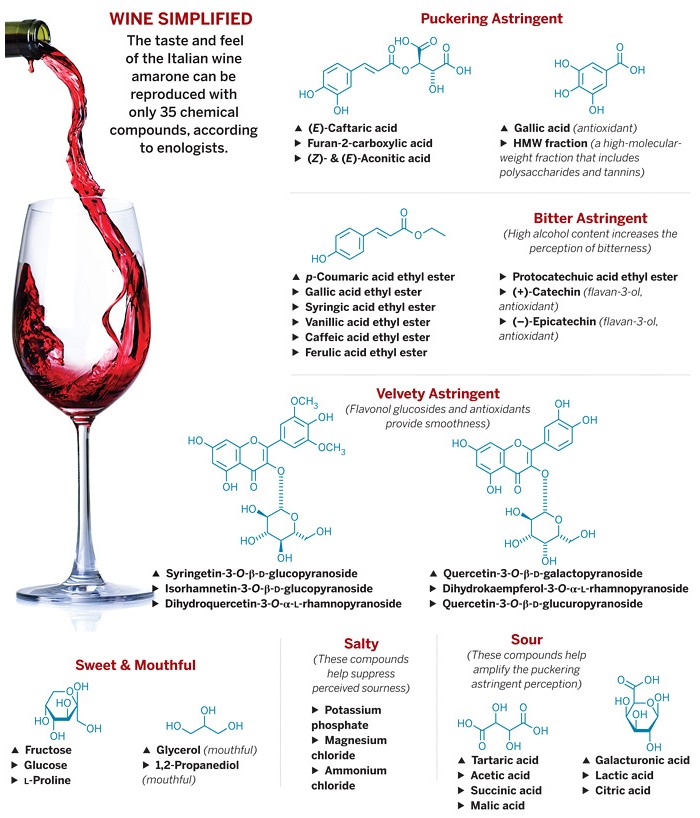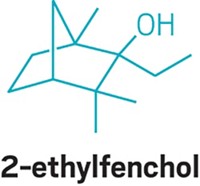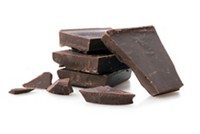Advertisement
Grab your lab coat. Let's get started
Welcome!
Welcome!
Create an account below to get 6 C&EN articles per month, receive newsletters and more - all free.
It seems this is your first time logging in online. Please enter the following information to continue.
As an ACS member you automatically get access to this site. All we need is few more details to create your reading experience.
Not you? Sign in with a different account.
Not you? Sign in with a different account.
ERROR 1
ERROR 1
ERROR 2
ERROR 2
ERROR 2
ERROR 2
ERROR 2
Password and Confirm password must match.
If you have an ACS member number, please enter it here so we can link this account to your membership. (optional)
ERROR 2
ACS values your privacy. By submitting your information, you are gaining access to C&EN and subscribing to our weekly newsletter. We use the information you provide to make your reading experience better, and we will never sell your data to third party members.
Environment
A Taste Of Wine Science
ACS Meeting News: Researchers zero in on flavor molecules, ponder ways to control them during production
by Lauren K. Wolf
September 22, 2014
| A version of this story appeared in
Volume 92, Issue 38
If you’ve ever slapped $5.00 down on a bar to taste a winery’s offerings, you’ve likely been regaled with tales of the art of winemaking. While patrons clink their glasses and chatter about a vintage’s body, winemakers and their staff typically point out how grape quality, barrel aging, and a particular year’s weather contributed to their products’ flavors and aromas. Rarely do they mention monitoring their merlot’s pH or tracking the amount of methoxypyrazine that accumulated in their cabernet’s grapes. Science talk, in other words, is avoided like the plague.
“Consumers prefer it that way,” enologist Gavin L. Sacks recently told C&EN. “Part of the appeal of wine is the idea that the producer did not exercise complete control over the process.”
Indeed, many of the environmental factors that shape a wine’s sensory profile, including humidity and average rainfall, are out of a winery’s hands. But there are numerous points along a grape’s journey to becoming a wine where experts can—and do—scientifically intervene to influence the final beverage.
Wine researchers gathered last month to discuss some of these intervention strategies during a session held at the American Chemical Society national meeting in San Francisco. During the symposium, sponsored by the Division of Agricultural & Food Chemistry, enologists reported on their efforts to isolate wine’s flavor components and control them to make a better product.
“Grape growers and winemakers, they might give the illusion that they’re talking to the vines and just letting nature happen,” said Sacks, a professor at Cornell University and coorganizer of the symposium. “But there are stacks of periodicals in many of their offices—technical and peer-reviewed journals—and they read every detail.”
Scientists such as Sacks have long been trying to understand the interplay of a wine’s chemical components so that they can help winemakers achieve desired tastes and aromas. In the 1970s and ’80s, enologists began in earnest to analyze wines and correlate individual compounds with sensory attributes. Because of advances in analytical techniques, they managed to nail down many of the key molecules during the 2000s.
One researcher who’s made major contributions to this area of research is Thomas Hofmann, a food chemist at the Technical University of Munich (TUM). In San Francisco, he dazzled the audience by describing his team’s efforts to strip a wine down to its key flavor components—the ones that humans sense when they take a sip.
Nobody knows for sure exactly how many compounds a glass of wine comprises, Hofmann told C&EN. “But it’s definitely in the thousands.”
To zero in on the small group that dictates a wine’s flavor profile, Hofmann and his team rely on both analytical methods and a panel of volunteers trained over a two-year period to identify sensory attributes such as “sour” and “astringent,” which is a drying sensation in the mouth. In 2008, the researchers began their in-depth studies, using liquid chromatography to divide a high-quality Italian dry red wine, amarone, into molecular fractions. Their volunteers labeled each fraction as “sweet,” “mouthful”—a descriptor for richness—and so on.
Once the researchers had this information, they used mass spectrometry to identify the specific compounds in each fraction and finally “reengineered” a wine. To make this synthetic beverage, the researchers selected 80-some molecules from their fractions and added them to water at concentrations normally found in amarone. Working with the trained tasters, Hofmann and his team then removed a few compounds at a time until they were left with the 35 molecules that were sufficient to simulate the taste and feel of a real amarone (J. Agric. Food Chem. 2008, DOI: 10.1021/jf073031n and 10.1021/jf801742w).
According to Hofmann, these “orosensory” molecules are not all it takes to reconstitute amarone. Another 25 or 30 volatile compounds are required to describe its aroma—an important part of the overall experience of drinking a wine.
He and his team have continued using their so-called sensomics approach to investigate a multitude of other wines. They’ve found that the same 60 or so key aroma and taste molecules describe every wine. And what makes one wine taste like a merlot and another taste like a cabernet sauvignon is the difference in these key compounds’ concentrations. “That’s also why, even if you have a wine from the same winery this year and last year, they might taste similar but not identical,” Hofmann said. In the vineyard, “minor changes in the molecules’ concentrations are induced in the grapes by variations in temperature, humidity, and so on.”

SOURCES: Hofmann laboratory/TUM, J. Agric. Food Chem. 2008,ODHOI: 10.1021O/jHf073031n and 10.1021/jf801742w
Download a PDF of the graphic here.
Some wine researchers are now trying to understand how these types of environmental factors affect the chemical composition of grapes and, in turn, wine. At the ACS meeting, Hildegarde Heymann, an enologist at the University of California, Davis, presented her team’s study on the role a vineyard’s location plays in a wine’s aroma. The researchers used gas chromatography-mass spectrometry to analyze the volatile compounds emitted by about 40 malbecs from regions of California, such as Napa Valley, and regions of Argentina in the high-altitude Mendoza province. Then they mathematically correlated prominent aroma molecules with sensory data reported by a panel of trained odor experts.
Susan E. Ebeler, a member of the UC Davis team, told C&EN that the “cool” thing about this study is that all the malbecs were produced in the same way. Working with vineyards on both continents, the researchers ensured that the grape crushing, fermentation, and aging steps were as similar as possible between wines. This way, the team could tease out the molecular and sensory differences caused solely by where the grapes were grown, said Ebeler, also a coorganizer of the ACS meeting symposium.
The UC Davis team found that the Argentinian malbecs were sweeter and contained more alcohol than the Californian malbecs, which were more bitter (Food Chem. 2014, DOI: 10.1016/j.foodchem.2013.07.085). They think a majority of the differences between the two types of wine have to do with the altitude at which the grapes were grown. Rainfall plays a smaller role. The team hopes this study will provide a jumping-off point for more in-depth investigations of how a wine’s chemical composition is influenced by its provenance.
Given that vineyard conditions such as rainfall help shape the tastes and aromas that ultimately appear in wine, researchers would also like to identify “what kinds of things we can do in the vineyard to impact a wine’s flavor profile,” Ebeler said.
Michael T. Cleary, director of chemistry at E. & J. Gallo Winery, in California, shared some thoughts with the audience in San Francisco on a few of these vineyard strategies. Gallo buys grapes from vineyards across California to make its vino, so it’s interested in why grape quality varies from estate to estate. Cleary and his team analyze grape composition daily and, on the basis of their experience, have come up with what they call objective measures of grape quality.
One of these measures is the amount of 3-isobutyl-2-methoxypyrazine found inside grapes. This volatile compound has a vegetal, bell pepper odor that, at high concentrations, is displeasing to consumers. Researchers, including Cornell’s Sacks, have determined that grapes exposed to direct sunlight accumulate less of the odorant than grapes in the shade.
Rather than filter the troublesome compound out of wine with substances such as charcoal—which might also remove beneficial molecules—Cleary suggested pruning leaves from vines to expose grape clusters to more direct light.
Another quality marker Cleary discussed at the ACS meeting is a wine’s tannin level. Tannins are polyphenols that cause a gritty sensation in the mouth by binding to salivary proteins there. Consumers enjoy tannins in red wines, but enologists have learned that just because a grape contains a lot of tannins doesn’t mean the corresponding wine will too.
Sacks and his team recently showed that the amount of tannins extracted during winemaking inversely correlates with the amount of protein on the cell walls within a grape’s flesh. This finding suggests that tannins bind so tightly to the proteins that they can’t release into the wine (J. Agric. Food Chem. 2014, DOI: 10.1021/jf5023274). To boost the tannin level in vino, Sacks suggested that winemakers might add a protease to the crushed grapes during the winemaking process to degrade the interfering proteins.
Once researchers have a better grip on which step in the wine manufacturing process generates which important flavor compound, they’ll be able to help winemakers improve their products, TUM’s Hofmann said. If the molecules and reactions that produce them are unknown, winemaking is just trial and error, “or art, as you might call it,” he said. By adding scientific know-how, “it can still be art, but we can help a winemaker a little bit to better hit their target.”








Join the conversation
Contact the reporter
Submit a Letter to the Editor for publication
Engage with us on Twitter